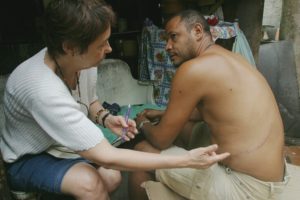Boston Review has posted today an excerpt of Rachel Ablow’s Interview with Elaine Scarry in our current special issue, The Social Life of Pain. Read the full interview here, and check out the issue introduction (free for a limited time) here.
Monthly Archives: July 2019
Legacies of Pain
A Finger in the Wound: On Pain, Scars, and Suffering
by Nancy Scheper-Hughes


from the section “The Embodiment of Pain”:
Margaret Lock’s and my 1987 essay, “The Mindful Body: A Prolegomenon to Future Work in Medical Anthropology,” emerged out of our profound dissatisfaction with the limitations of our discipline and field of inquiry. What good, after all, was a medical anthropology that was simply a convenient application of anthropological ideas and methods to clinical models of illness, pain, suffering, and healing? We wanted our field to be transformative, both theoretically and in terms of praxis. So we began to sketch a framework suggesting what medical anthropology could do beyond an empathic handholding of doctors and patients. We questioned the body as a cultural, historical, medicalized, naturalized, and universal object. We introduced the notion of embodiment, or how people, individually and collectively, live in and experience the body-self. We devised a tripartite framework of the “three bodies”: the individual body/the body self; the social body; and the political body or the body politic. The three bodies represent, then, three different but overlapping levels of analysis and theory: the existential/phenomenological/ontological individual body; the social structural/symbolic (the social body); and the feminist/neo-Marxist, Foucauldian body as a site of power/knowledge (the political body).
The individual body is a given, biopsychological, existential reality. It refers to the processes of becoming and being a person, an embodied self. In this instance, the body is seen as unique, singular, individual, and personally experienced. At the same time, this “individual” body—conceived as the center of the perceiving, experiencing, thinking world—is always mediated through collective cultural meanings. The self-evident yet contradictory proposition is that humans both have and are bodies. Our bodies are simultaneously objects of and subject to our “selves.” We could say that we are at one and the same time insiders and outsiders to ourselves. The message of the American wellness movement at the time we were writing was rather crude: “It’s your body. Take care of it.” The concept of the body as property means that you own it and you have the responsibility to take care of it. But on a deeper level, the body is proof of one’s existence. It is through the body and its sensory and perceptual circuits that we are able to experience and differentiate among other objects and things in the world. The body, wrote Marcel Mauss, is the “first and most natural tool” of humans. But here’s the rub: how can one simultaneously be it and own it?
In his classic work The Phenomenology of Perception, Maurice Merleau-Ponty argued that although humans are not unique in being embodied, they might be the only species that is en-selved, endowed with self-consciousness, self-awareness, and self-reflection. While primates and other animals grieve the death of their loved ones, only humans are painfully conscious of the limits of their being-in-the-world. Ludwig Binswanger, drawing on Edmund Husserl and Martin Heidegger, writes of “thrownness”: the idea that individual bodies are “thrown” into a particular world, place, history, and existence without their choosing. Our genetic inheritance, generation, environment, and society; our family, race, culture, and history are thrown at us, as the raw materials out of which to create a life.
On the one hand, then, our bodies are the “tools” with which we perceive, think, and act in and on the world; on the other, bodies can seem to betray us, to defeat us. In extreme situations, our bodies can even seem to be obstacles to our freedom. Bodies can frustrate our basic needs and deepest desires. The suffering of transgender people is just one example of a body betrayed. One might, like Albie Sachs, an anti-apartheid hero, lose a limb in a political attack on one’s life. Albie’s suffering during a long recovery eventually shaped him into a more open and compassionate human and an even better ANC (African National Congress) warrior. Albie was proud of his missing limb and refused to wear a prosthesis. He would wave his empty sleeve as if it were his flag of liberty, which I thought it was. Or, like Diane DeVries, one could be born without any limbs at all and refuse the sometimes very painful attempts to navigate on the remaining stumps. The pain was worth her self-perception as a unique beauty, an American Venus de Milo. Continue reading …
Pain is a deeply subjective experience that includes sensory, emotional, social, historical, and cultural components. The presence of suffering in the idiom of pain exposes the gap between individual bodies that refuse to suffer quietly and the violence of indifferent social, economic, and political orders. In this essay Nancy Scheper-Hughes describes the existential suffering of Brazilian sugarcane cutters who transform the unbearable shame of hunger into a more acceptable bodily syndrome of nervous rage. Who, after all, wants to suffer and die like a dog? Her second example of the precariousness of pain is the muted suffering and longing of impoverished kidney sellers in Moldova who suffer a missing kidney that they experience as an angry and ghostly organ that will not allow the sellers to forget what they have done to themselves.
NANCY SCHEPER-HUGHES is Chancellor’s Professor of Anthropology and Professor of the Graduate School at UC Berkeley. She is the author of many books, including Saints, Scholars and Schizophrenics: Mental Illness in Ireland (1979, 2001), and Death Without Weeping: The Violence of Everyday Life in Brazil (1993). As founding director of Organs Watch, she is a consultant on human trafficking of organs for the EU, Interpol, the UN Office on Human Trafficking, and the Vatican. Her forthcoming books are The Ghosts of Colonia Montes de Oca: A Hidden Subtext of Argentina’s Dirty War and Kidney Hunter: Trafficking with the Organs Traffickers.
Torture and Truth
Is There Truth in Pain?
by Darius Rejali
The essay begins:
The general problem is one familiar to many scholars whose careful work founders on public resistance. The particular form that interests me concerns scholarly work on torture. Many scholars feel there is truth to be discovered in pain, and therefore torture reveals or extracts truths, at least sometimes. I’m interested in reflecting on this disposition.
Scholarly work in this area seems to break repeatedly on the rocks of what Aristotle calls endoxa, items of thought that might be based on empirical observations, perceptual evidence, or things that we might not call observations at all—such as propositions that strike people as true or commonly said or believed. For Aristotle, these include common dispositions like “the many are wiser than the few” or “the fewer are wiser than the many” or, as he discusses in the Rhetoric, the belief that “torture works.”
Some scholars also argue sincerely that torture “works,” and they make arguments in service of their political or moral views. These scholars don’t concern me here. They share in a community of reason, where their arguments and evidence can be evaluated. What interests me instead is how many people simply don’t care about these pro-torture arguments. They don’t cite the pro-torture scholars, nor do they pay them much attention. They already know that torture works to produce truth. They believe pain yields truth, and thus torture works. Maybe not always, but torture works sometimes, they say. Even people who oppose torture sometimes privately confess: I would have confessed the truth under torture even if you say it won’t work. Secretly, they feel that pain and discovering the truth are related.
I find this curious. So in 2008 I began to itemize the cultural elements that subtly, in their own way, support the belief that there is truth in pain. In this paper, I’m going to talk about four endoxa. For three of them, I can’t claim any originality; they are well known—all I do is link them to torture specifically. I will not endeavor to offer their genealogies—though I will gesture to their necessary components. The fourth, the story of Zahra and the saints, arises from my own research in the psychiatric files of torture victims.
In what follows, I speak of torture. For my purposes, I don’t think it matters whether we are talking about torture for confessions or information, or as a means of deterrence—in fact, the endoxa I identify cloud the distinction and merge them by various means. Likewise, I would argue that one reason the definition of torture is hazy and contested is because these endoxa blur the edges between what we do publicly and privately, between what is true of us and true of others, between torture and other ordinary activities. Continue reading …
In this essay Darius Rejali explores four ways in which we believe truth can be found in painful experiences, even among those people who doubt that torture “works.” These endoxa, or commonplace beliefs, tap into deep human anxieties—about manhood, the maintenance of a just world, the meaning of suffering, and the possibility of transcending injustice. As such, they make it difficult for people to hear arguments against torture, including coerced interrogation. The essay suggests alternative ways of engaging these beliefs while acknowledging the challenge of dislodging them.
 DARIUS REJALI is Professor of Political Science at Reed College and the author of the award-winning book Torture and Democracy (2007). Interviewed widely, Rejali is an internationally recognized expert on government torture and interrogation, and he has submitted testimony for Guantanamo- and Abu Ghraib-related cases.
DARIUS REJALI is Professor of Political Science at Reed College and the author of the award-winning book Torture and Democracy (2007). Interviewed widely, Rejali is an internationally recognized expert on government torture and interrogation, and he has submitted testimony for Guantanamo- and Abu Ghraib-related cases.
